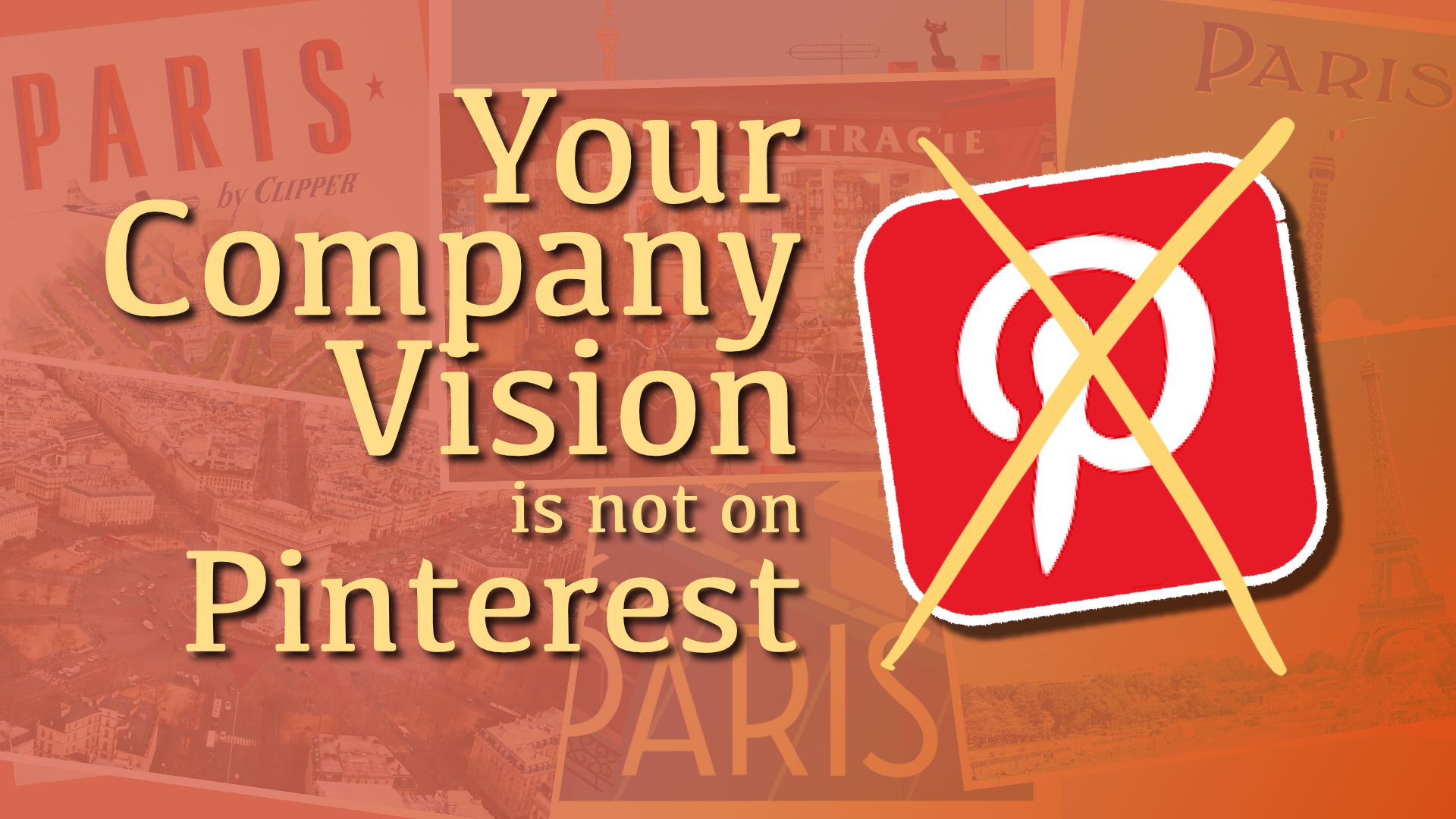Your Company Vision is not on Pinterest
Imagine you’re planning a vacation and you’re going to share it with a co-worker. You’re telling them about white sandy beaches, verdant green palm trees, and clear blue ocean coves. Or perhaps 300-year-old architecture, boat rides down a canal, and lamp lights illuminating cobbled streets.
There’s a good chance that your co-worker shares a pretty good idea of your destination. They can easily picture the sort of location you’re jetting off to or the experience you’re going to have. That’s because you’re planning to go someplace that is known or at least is made up of elements that are familiar. Most of us have seen those images before; on tv, in magazines, and online.
Words alone can work for ideas that are familiar. Even then, images strengthen the signal.
Things get tricky when asking people to imagine something that they’ve never experienced before. This is why ideas that are cultural, generational, and even personal, are more difficult to share with words alone.
This is what’s happening when you communicate the vision of your company to investors, leaders, and employees.
You tell them about becoming the best in your industry, scaling 10x, and providing 360-degree service to your clients. Or perhaps you talk about having innovation at your core, a flat organization, and open career paths.
There’s a good chance that only a handful of your team has ever experienced or witnessed anything like the vision you hold for your company.
Where is that? What does that look like? How do you get there?
Innovating means choosing a destination that few organizations have been.
The people you lead can’t see it. You can’t Google it. Which means you’re much less likely to get there. That’s how important being able to physically see with our eyes is.
Seeing the Spark
From the beginning, when you first decide to take a trip you have to narrow down the options. You start by looking up pictures of these places. First, you Google the destinations for images. Then you visit Wikipedia pages and travel sites or find a book at the library. Eventually, you find yourself on Pinterest. Curated collections of images present the ultimate version of the trip you hope to have.
There isn’t a Google images search result or Encyclopedia Britannica entry that depicts where your business is going. There’s no travel agency or Wikipedia page.
And you will not find the vision for your business on Pinterest.
If you try and picture a successful business, you might see a large building with your name on it. Maybe it’s in a prominent city. That’s how we imagine many Fortune 100 companies.
You might imagine modern stylistic furniture bean bags and ping pong tables from stories you’ve heard about fast-growing Silicon valley start-ups. Often that’s just window dressing, not the whole picture or the substantive part of their success.
Looking to Those That Came Before US
One medium that humans can process in a similar way to visuals is stories. More accurately this method allows our imaginations to fill in the blanks more easily. There are books, articles, and documentaries about businesses and leaders that we look to for a picture of success
We read about purpose-driven organizations scaling the mountains of record revenue growth. These stories share what they accomplished and how they made it. The path they took to somewhere new, somewhere exotic.
I just started reading “Delivering Happiness” by the late Tony Hsieh. This book contains the path Zappos took to reach $1B in sales in less than 10 years. Tony shares his personal entrepreneurial journey. Towards the end, he provides some frameworks that can be used to reflect and strengthen the vision for your business. Reading books like this inspires many of us and gives us perspective to add to our foundation and tools for our toolbox.
But even if we want to take our company in a direction as Tony Hsieh did, his book isn’t going to get us there. Here’s why.
Visuals Stick With Us
You could give everyone in your company the same book and they each take different lessons from it of what the future could be. They still may have no idea what your vision for the company is.
Here’s the kicker. Only 10% of the information your team reads or hears is sticking with them.
People are visual processors. We evolved with sight as our dominant sense, for good or ill. That same information when delivered visually is better understood and 6x more likely to stick in their mind. Every part from planning to execution to evaluation is made better when our people see something.
Seeing is Believing
Back to your vacation. Being able to preview the location and the sites influenced your decision to go to a tropical island over a European city or vice versa. Picturing yourself in one setting or another is what builds your excitement for going. It builds your resolve for doing the hard work to get there; the planning, preparation, managing funds, and whatever arrangements we have to make sure our home and work aren’t chaotic when we return.
For most of us, it would be ridiculous to do any of that without a clear picture of where we’re going. So often this is exactly what we expect of the organizations and people we lead. But there is no Pinterest for your business. No images exist of where your business is going.
The future of your business can be visualized.
Think It, See It
Hollywood is full of hundreds of crews that bring imagination to the big screen. George Lucas had an idea of what the alien cantina could look like on Luke Skywalker’s home planet, but it took creature artists, puppeteers, cinematographers, and actors to translate those words into visuals and bring it to life. These imagination translators put a world that doesn’t exist in front of our eyes, and it expands what we are able to imagine. But you don’t have to look to Hollywood.
Of all the things I’ve learned to do to build brands that resonate or create memorable customer experiences, cultivating the skill of visual thinking has served me the most.
I’ve brought people joy with a single sketch and I’ve won business by being able to show definitively that I understand the problem on the back of a napkin.
When I started a whiteboard video production company back in 2011, we thought we were just chasing a stylistic trend at first. It didn’t take long to realize how powerful the simple drawn image was at conveying huge, complex, difficult ideas. To adapt a phrase, drawings punch way above their weight class.
We started Relumed trying to imagine a new way of thinking and seeing business.
Visualizing conversations are the window into the minds of the leaders we serve. Drawn images put those thoughts into physical form that can be explored and shared. Through this combination, we make the intangible, tangible. The invisible becomes visible. The idea that is difficult to share and easily forgotten, is easy to share and catches fire in each of the people you share it with.
Go Ahead, Create Your Own Pictures
So when you want to convey your vision, use drawing and visual thinking to find clarity for yourself. Find a visual thinker in your midst. Your organization likely has one or two. They’re the ones who doodle at meetings or are asked by their peers to work their magic on the whiteboard.
It can be crude to start. Visual thinking isn’t about masterpieces, it’s about showing ideas and how they connect.
You can hire professional visual thinkers, like us, for our experience listening and visualizing the right details.
You can even train people in your organization to bring visual thinking to your meetings and communication. Those sketches and whiteboard drawings can be given to a designer and made beautiful and branded.
When it comes time to share your vision with your leadership, employees, potential investors, and partners, you should always communicate visually.
Infographics, videos, etc are worth the time and cost to create. And you have to make them custom to your company and your vision. Because the vision of your business isn’t on Pinterest.



